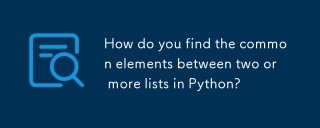 Backend Development
Backend Development Python Tutorial
Python Tutorial Solve the problem that LabelEncoder cannot recognize previously 'seen' tags
Solve the problem that LabelEncoder cannot recognize previously 'seen' tags
This article aims to resolve the "y contains previously unseen labels" error encountered when encoding data using LabelEncoder. This error usually occurs when there are different category tags in the training set and the test set (or validation set). This article will explain the causes of the error in detail and provide the correct encoding method to ensure that the model can handle all categories correctly.
When encoding category data using LabelEncoder, you often encounter a common error: "ValueError: y contains previously unseen labels". This error usually occurs in the following scenario: you fit the LabelEncoder using the training set, and then try to transform the dataset (for example, a test set or a validation set) that contains the category labels that do not appear in the training set.
Analysis of the cause of error
LabelEncoder works by assigning a unique integer to each unique category label. When you use the fit method, LabelEncoder learns all the unique category labels in the training set and creates a mapping from labels to integers. When you use the transform method, LabelEncoder looks for the corresponding integer for each label. If the transform method encounters a label that has not been seen in the fit phase, it cannot find the corresponding integer, thus throwing a "unseen labels" error.
Error code example
The following code demonstrates common practices that cause this error:
import pandas as pd
from sklearn.preprocessing import LabelEncoder
# Assume that tr_df is the training set DataFrame, and cv_df is the verification set DataFrame
encodable_columns = ['Education', 'EmploymentType', 'MaritalStatus',
'HasMortgage', 'HasDependents', 'LoanPurpose', 'HasCoSigner']
le = LabelEncoder()
# Wrong practice: Apply fit_transform to each column of DataFrame
encoded_df = cv_df[encodable_columns].apply(le.fit_transform)
cv_df.drop(columns=encodable_columns, axis=1, inplace=True)
cv_df = pd.concat([tr_df, encoded_df], axis=1) # This line of code may be incorrect. Please check whether you need to connect tr_df and cv_df
encoded_df = tr_df[encodable_columns].apply(le.transform)
tr_df.drop(columns=encodable_columns, axis=1, inplace=True)
tr_df = pd.concat([tr_df, encoded_df], axis=1) # This line of code may be incorrect. Please check whether you need to connect tr_df and cv_df
The error with the above code is that you try to apply le.fit_transform to each column of the DataFrame using the apply method. Doing so will cause LabelEncoder to fit individually on each column instead of using a global view of all category labels in all datasets.
The correct solution
The correct way is to create an independent LabelEncoder instance for each column, first use the training set fit each LabelEncoder, and then use the training set fit good LabelEncoder to transform the training set and validation set.
import pandas as pd
from sklearn.preprocessing import LabelEncoder
# Assume that tr_df is the training set DataFrame, and cv_df is the verification set DataFrame
encodable_columns = ['Education', 'EmploymentType', 'MaritalStatus',
'HasMortgage', 'HasDependents', 'LoanPurpose', 'HasCoSigner']
# Create a dictionary to store the LabelEncoder for each column
label_encoders = {}
# Looping for col in encodable_columns:
# Create a LabelEncoder instance for the current column label_encoders[col] = LabelEncoder()
# Fit LabelEncoder using training set
tr_df[col] = label_encoders[col].fit_transform(tr_df[col])
# Use the LabelEncoder fitted with the training set to convert the verification set cv_df[col] = label_encoders[col].transform(cv_df[col])
# If necessary, you can delete the original category column # tr_df.drop(columns=encodable_columns, axis=1, inplace=True)
# cv_df.drop(columns=encodable_columns, axis=1, inplace=True)
# Print the converted DataFrame (optional)
print("Training Data:")
print(tr_df.head())
print("\nValidation Data:")
print(cv_df.head())
Code explanation
- Create a LabelEncoder dictionary: label_encoders = {} Create a dictionary that stores the LabelEncoder instance for each column.
- Looping to process each column: for col in encodable_columns: Looping through each column that needs to be encoded.
- Create a LabelEncoder instance: label_encoders[col] = LabelEncoder() Creates a new LabelEncoder instance for the current column and stores it in the label_encoders dictionary.
- Use the training set fit and transform: tr_df[col] = label_encoders[col].fit_transform(tr_df[col]) First use the training set fit LabelEncoder, and then use the same LabelEncoder to transform the training set.
- Use the training set fit to convert the validation set to the good LabelEncoder: cv_df[col] = label_encoders[col].transform(cv_df[col]) Use the previous training set to the good LabelEncoder to convert the validation set. Note: Only transform is used here, and fit is no longer used. This is the key to make sure that the validation set uses the same encoding rules as the training set.
Things to note
- Data consistency: Ensure that the category labels of the training set and the test set (or validation set) are semantically consistent. For example, if the "High School" in the training set is encoded as 0, the "High School" in the test set should also be encoded as 0.
- Unknown tag handling: LabelEncoder still throws an error if the test set contains tags that do not appear in the training set. In this case, you need to consider using other encoding methods, such as One-Hot Encoding, or manually adding an "unknown" category to the training set and encoding it as a specific integer.
- Other encoding methods: LabelEncoder is suitable for situations where there is no intrinsic order relationship between category labels. If there is an sequential relationship between category tags (e.g., "Low", "Medium", "High"), then the OrdinalEncoder should be used. For more complex situations, consider One-Hot Encoding.
Summarize
LabelEncoder is a convenient category data encoding tool, but must be used correctly to avoid "unseen labels" errors. The correct way is to create an independent LabelEncoder instance for each column, first use the training set fit each LabelEncoder, and then use the training set fit good LabelEncoder to transform the training set and validation set. At the same time, it is necessary to pay attention to data consistency and consider how to deal with unknown tags.
The above is the detailed content of Solve the problem that LabelEncoder cannot recognize previously 'seen' tags. For more information, please follow other related articles on the PHP Chinese website!
 How do you find the common elements between two or more lists in Python?Aug 27, 2025 am 05:27 AM
How do you find the common elements between two or more lists in Python?Aug 27, 2025 am 05:27 AMThe most efficient way to find common elements of two or more lists is to use the intersection operation of the set. 1. Convert the list to a set and use the & operator or .intersection() method to find the intersection, for example, common=list(set(list1)&set(list2)); 2. For multiple lists, you can use set(list1).intersection(set(list2), set(list3)) or set.intersection(*map(set,lists)) to achieve dynamic processing; 3. Pay attention to the disordered and automatic deduplication. If you need to maintain the order, you can traverse the original list and combine the set judgment.
 How to parse a URL to extract its components in Python?Aug 27, 2025 am 05:19 AM
How to parse a URL to extract its components in Python?Aug 27, 2025 am 05:19 AMUse urllib.parse.urlparse() to parse the URL into components such as scheme, netloc, path, query, fragment; 2. Access various parts through properties such as parsed.scheme, parsed.netloc; 3. Use parse_qs() to convert the query string into a dictionary form, and parse_qsl() to a tuple list; 4. Hostname and port can extract the host name and port number respectively; 5. Combinable functions can implement complete URL analysis, which is suitable for most URL processing scenarios, and finally return the structured result to the end.
 Efficient update of JSON data: Inventory management optimization practices in Discord.py applicationsAug 27, 2025 am 04:45 AM
Efficient update of JSON data: Inventory management optimization practices in Discord.py applicationsAug 27, 2025 am 04:45 AMThis article aims to guide developers how to efficiently update JSON data, especially in the Discord.py application and other scenarios. By analyzing common inefficient file operation modes, an optimization solution is proposed and demonstrated: load JSON data into memory at one time, and after all modifications are completed, the updated data is written back to the file at once, thereby significantly improving performance and ensuring data consistency.
 How does inheritance work in PythonAug 27, 2025 am 03:14 AM
How does inheritance work in PythonAug 27, 2025 am 03:14 AMInheritanceinPythonallowsaclasstoinheritattributesandmethodsfromanotherclass,promotingcodereuseandestablishingahierarchy;thesubclassinheritsfromthesuperclassusingthesyntaxclassChild(Parent):,gainingaccesstoitsmethodslikegreet()whileoptionallyoverridi
 Python calculates office hours: CSV data processing and time difference calculationAug 26, 2025 pm 04:45 PM
Python calculates office hours: CSV data processing and time difference calculationAug 26, 2025 pm 04:45 PMThis article aims to provide a Python script for reading data from a CSV file and calculating the office hours corresponding to each ID within a specific month (such as February). The script does not rely on the Pandas library, but uses the csv and datetime modules for data processing and time calculation. The article will explain the code logic in detail and provide considerations to help readers understand and apply the method.
 Solve the problem of SSL certificate verification failure during PyTerrier initializationAug 26, 2025 pm 04:42 PM
Solve the problem of SSL certificate verification failure during PyTerrier initializationAug 26, 2025 pm 04:42 PMWhen initializing using PyTerrier, users may encounter a ssl.SSLCertVerificationError error, prompting certificate verification failed. This is usually caused by the system's inability to obtain or verify the local issuer certificate. This article will explain the causes of this problem in detail and provide a way to quickly resolve the problem by temporarily disabling SSL certificate verification, while highlighting its potential security risks and applicable scenarios.
 Python list numerical cropping: a practical guide to limiting the range of numerical valuesAug 26, 2025 pm 04:36 PM
Python list numerical cropping: a practical guide to limiting the range of numerical valuesAug 26, 2025 pm 04:36 PMThis article describes how to use Python to crop a value in a list so that it falls within a specified upper and lower limit range. We will explore two implementation methods: one is an intuitive method based on loops, and the other is a concise method that uses min and max functions. Help readers understand and master numerical cropping techniques with code examples and detailed explanations, and avoid common mistakes.
 Solve the problem that LabelEncoder cannot recognize previously 'seen' tagsAug 26, 2025 pm 04:33 PM
Solve the problem that LabelEncoder cannot recognize previously 'seen' tagsAug 26, 2025 pm 04:33 PMThis article aims to resolve the "y contains previously unseen labels" error encountered when encoding data using LabelEncoder. This error usually occurs when there are different category tags in the training set and the test set (or validation set). This article will explain the causes of the error in detail and provide the correct encoding method to ensure that the model can handle all categories correctly.


Hot AI Tools

Undress AI Tool
Undress images for free

Undresser.AI Undress
AI-powered app for creating realistic nude photos

AI Clothes Remover
Online AI tool for removing clothes from photos.

Clothoff.io
AI clothes remover

Video Face Swap
Swap faces in any video effortlessly with our completely free AI face swap tool!

Hot Article

Hot Tools

Zend Studio 13.0.1
Powerful PHP integrated development environment

SublimeText3 Chinese version
Chinese version, very easy to use

EditPlus Chinese cracked version
Small size, syntax highlighting, does not support code prompt function

Atom editor mac version download
The most popular open source editor

Notepad++7.3.1
Easy-to-use and free code editor





